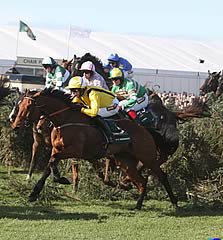 |
|
|
| John Smith's Grand National - 14th April 2012 |
BHA Publishes Results of Grand National Safety Review
02/11/11
The British Horseracing Authority has concluded its detailed Review into the Grand National. The report, The Grand National: A Review of Safety and Welfare – has today been published in full.
 |
The Review has led to the publication of 30 recommendations designed to continue enhancing the safety and welfare of the Grand National and on the Grand National course, while, crucially, retaining the race’s unique and challenging character.
The Review Group considered a large amount of statistical data and technical information relating to the Grand National and the Grand National course. The Aintree Managing Executive were involved throughout the Review. The Group also consulted extensively, including with representatives from the Aintree Veterinary Team; the Jockeys and the Professional Jockeys Association; Racehorse Trainers and the National Trainers Federation and animal welfare organisations including the RSPCA, SSPCA and World Horse Welfare.
The Review covers issues as diverse as the condition of the racing surface, the structure and design of the Grand National course fences, race day procedures, on-course veterinary and medical services, and the eligibility of both jockeys and horses to take part in the Grand National. Some of the Review’s findings relate directly to events in the 2011 running of the race, while others would be part of any continuing review as part of the detailed analysis and consultation processes. Safety and welfare have always been monitored. The Review at this time is part of this on-going process, and further monitoring will continue in the future.
The main recommendations of the Review are:
- Several changes relating to the structure of and groundwork around fences in the race (which have already been communicated as part of an announcement by Aintree on 15th August 2011, and are now complete).
- Minimum age of horses eligible to be entered in the race to be increased to seven from six years, and all horses to have previously finished 4th or better in a Steeplechase under Rules of three miles or further
- Various elements of pre and post-race procedures to be reviewed and enhanced, including arrangements at the pull-up area
- Bypassing of fences to continue, with customised equipment
- Improved processes for identifying and responding to weather related risks
- More targeted suitability criteria for all the race’s participants, and increased membership for the existing Authority Panel which reviews the suitability of those horses entered in all races over the Grand National fences
- Existing raceday veterinary inspections (carried out by Authority Veterinarians) of all horses running in the Grand National to be extended to all races run over the Grand National fences
In addition, and separate to this safety and welfare Review, The Authority’s Jump Racing Sub-Committee has resolved that the current minimum rating for runners in the Grand National be increased from 110 to 120 from 2012. This will better reflect the growing overall quality of entrants.
The responsibility for carrying out the recommendations now rests principally with the Aintree Executive, with the support of The Authority, and also partially with The Authority itself, where applicable.
The Review Group also recognised that there was scope for improvement in the communication of welfare issues and measures both within the sport and to the general public, via the media. Primary responsibility for broadcast media coverage of individual race meetings rests with racecourses. The BHA is working separately on improving communication on welfare matters, on how welfare is presented, and on how racing will continue to meet the challenges of reducing risk wherever possible.
Paul Roy, Chairman of the British Horseracing Authority, welcomed the Review and said:
“The Grand National is one of Britain’s great sporting institutions. It is a unique event watched by many tens of thousands at Aintree and tens of millions of people around the world.
“A key reason for its enduring popularity is that it is the most challenging race in Great Britain and a supreme sporting test for jockeys and horses alike.
“The sad events at the 2011 Grand National demonstrated the risks that this race can present, and rightly focused world attention on one of the British Horseracing Authority’s core objectives: to protect the safety and welfare of Racing’s human and equine participants.
“The Review Group has submitted recommendations that will enhance the safety and welfare of jockeys and horses participating in the Race, whilst removing none of the magic that makes the Grand National one of the most exciting, best-loved and enduring sporting events in the world.”
Tim Morris, Director of Equine Science and Welfare, said:
“Racing is a sport with risks. We are open about this and always have been, and the Grand National is the most challenging race in Great Britain
“Events at the 2011 Grand National were upsetting for people directly involved in the sport and those who follow it. The deaths of two horses, alongside several other factors, ensured there was significant media and public attention on the issue of safety and welfare in the Grand National. As such it was right and proper that the BHA, as a responsible regulator, should conduct this Review, which follows from post-race monitoring every year. This will continue, as before, in future years.
“The Review process has been balanced, thorough and comprehensive. The Review Group, and the BHA Board, are confident that the 30 recommendations will help achieve the objectives of not only enhancing the safety and welfare of participants but also maintaining public confidence in both the sport, and the Grand National as a race.”
“We have learned some valuable lessons from the events of 2011, one of which is that we need to work harder and be more effective at communicating our positive, proactive welfare work. For example, the scenes of jockeys dismounting and water and oxygen being made available to horses post the Grand National were mistakenly interpreted as evidence of extreme fatigue on the part of the horses, when in fact the measures were designed to be pre-planned and preventative.”
Jamie Stier, Director of Raceday Operations and Regulation, said:
“The ethos of the Review Group was to seek to retain the essence and individuality of the Grand National, balancing this with reducing avoidable risk.
“The Group recognised that both the race and the Grand National course have been the subject of much scrutiny and have undergone a number of changes over the years. The Review Group noted how the race has evolved as a result of these changes and how the quality of runners in the race has improved and the public’s interest - as demonstrated by the raceday attendance, domestic and global viewing audiences - has been sustained.
“As part of the Review a wide range of proposals were considered and, in many cases the need for change was not found. These topics included discussions regarding the maximum number of runners in the race, the position of the start and run to the first fence. However, despite a lack of evidence which warranted change, the Group did conclude that there is merit in continuing to collate data and monitor results so that, if necessary, such subjects could be revisited in the future.”
Julian Thick, Managing Director of Aintree Racecourse, said:
“We welcome today’s Report and thank the BHA for its insights and recommendations, which complement and build on the course changes announced by Aintree in August. As the organisers of the Grand National, one of the biggest events in the global sporting calendar, the safety and welfare of horses and jockeys is our first priority.
“We are constantly reviewing and improving our procedures. We plan for twelve months and everything we do before, during and after the race is geared towards making sure the event is run as safely as possible. Aintree has played an active part in the Review process and has already announced and implemented some of the recommended changes to Grand National course and fence design. In the coming weeks and months, we will continue to implement these recommendations to further enhance safety at the course.”
